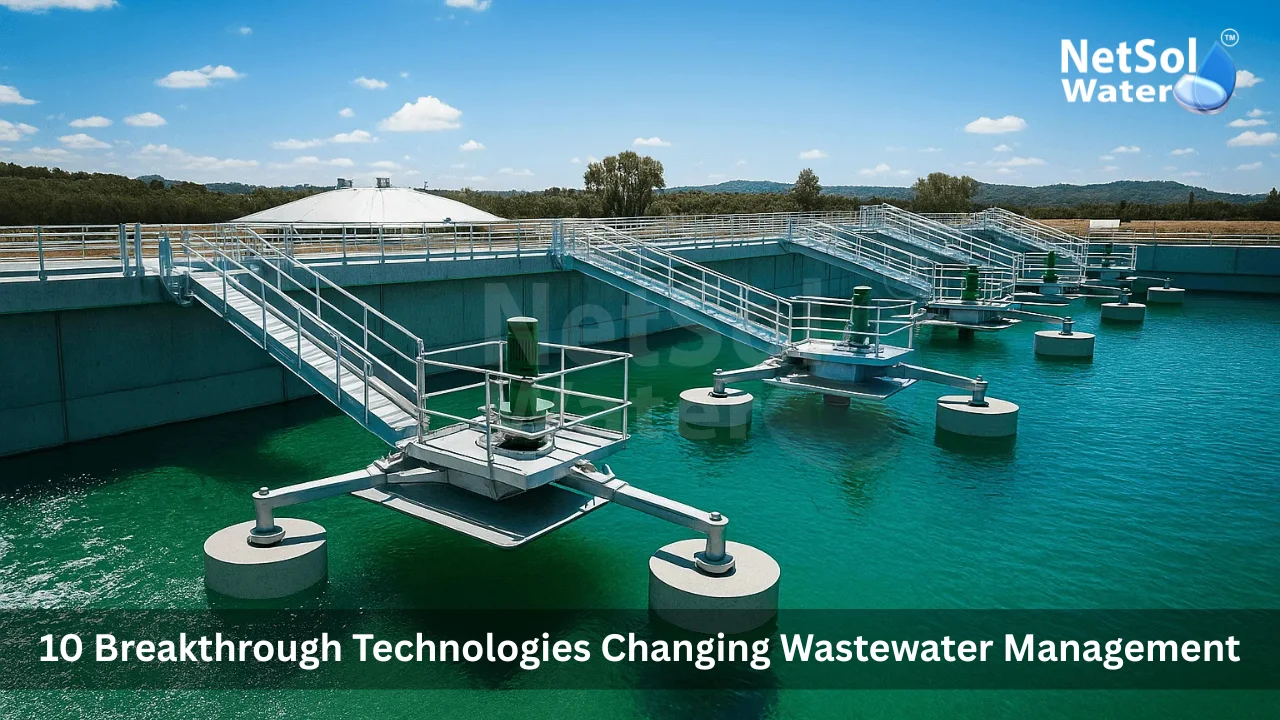
10 Breakthrough Technologies Changing Wastewater Management
Wastewater management faces new demands in this year. Cities grow fast and industries expand. Water scarcity has led to find the better solutions. Businesses now play a key role in meeting these needs. Netsol Water stands as a leading RO Plant Manufacturer in this field and the company helps many projects meet reuse goals and discharge rules. We will look at 10 breakthrough technologies that shape wastewater care and see how RO plants fit in.
1. Advanced RO Membranes
Advanced RO membranes help remove finer pollutants and last longer. Membrane makers tune material and pore design to stop new kinds of contaminants. Plants find that better membranes reduce energy use and lower waste. This leads to less frequent replacement and lower operating cost. Operators can push membranes to higher recovery rates without raising fouling. That helps factories and utilities save fresh water and lower discharge volumes. Netsol Water as a trusted RO Plant Manufacturer designs plants that match these new membranes with proper cleaning schedules and monitoring to protect membrane life.
2. Membrane Bioreactors MBR
MBR systems join biological treatment with membrane filtration for clean output. MBR reduces footprint and gives stable effluent quality. Plants that use MBR can meet strict discharge rules and reuse treated water for non potable uses. MBR also controls solids better and eases downstream membrane load. This improves the overall life of RO elements and cuts maintenance. Engineers plan MBR reactors to pair with RO plants to protect membranes and improve overall system reliability.
3. AI and IoT for Plant Monitoring
Digital tools let operators see plant health in real time. Sensors feed data to AI models that predict fouling leaks and energy spikes. The system alerts operators before a fault becomes a failure. This reduces downtime and saves chemicals and power. AI also tunes pump speeds and dosing to run more efficiently. An RO Plant Manufacturer that uses AI and IoT can deliver smarter packages and faster startup for new plants.
4. Electrochemical Treatment
Electrochemical methods break down stubborn pollutants without large chemical storage.
These methods suit plants that face industrial dyes, heavy metals and micro pollutants. Electrochemical units can reduce toxic load and prepare water for RO polishing. The approach cuts sludge and lowers handling risk. Designers combine electrochemical modules ahead of membranes to reduce fouling and extend membrane life.
5. Forward Osmosis
Forward Osmosis (FO) works with natural osmotic gradients to move water with less pressure. FO can preconcentrate waste streams and save energy before RO. That reduces the load on high pressure systems. FO also helps treat feeds that would normally foul RO membranes quickly. Operators use FO as a step to gain flexibility in challenging feed waters.
6. UV LED Disinfection
UV LED gives precise disinfection without chemicals. LED units switch on and off quickly and last long. They use less power for targeted tasks and need no storage tanks for chlorine. This reduces safety overhead and lowers final contaminant risk. Plants use UV LED for final polishing to meet reuse standards before sending water to RO or distribution.
7. Energy Recovery Systems
Recovering energy cuts plant cost and carbon output. Devices harvest pressure or heat from process streams and reuse it in pumps or heaters. This reduces external power need and lowers operating cost. When paired with efficient RO membranes energy recovery gives big savings over plant life.
8. Anaerobic Digestion and Biogas
Organic waste can produce energy and reduce disposal needs. Anaerobic digesters turn sludge into biogas which fuels boilers or generators. This cuts waste handling cost and yields renewable energy for plant use. Digesters also shrink waste volume and improve overall sustainability. Operators can use gas to power pumps and heat digesters to close the energy loop.
9. Nanotechnology and Advanced Adsorbents
Nano materials improve removal of trace contaminants. Adsorbents capture heavy metals micro pollutants and organics that pass other steps. These materials work as polishing layers before RO or after membrane stages to protect the main filters. Using advanced adsorbents reduces fouling pressure on RO membranes and improves final water quality.
10. Decentralized Modular Treatment
Modular plants let cities deploy treatment close to the source. Smaller modular units reduce the need for long sewer networks. They enable local reuse and faster installation. These units often include RO as a polishing step and use pre made modules for easier maintenance. A strong Reverse Osmosis Plant Manufacturer supports modular rollout and helps match modules to local water goals.
Read some interesting information for Industrial RO Plant Manufacturer
Conclusion
These technologies shape cleaner and smarter wastewater work. Netsol Water is the Top RO Plant Manufacturer and it can help you choose the right mix of solutions. If you want more details or a site consultation contact Netsol Water or request a technical meeting with their team.
Contact Netsol Water at:
Phone: +91-9650608473
Email: enquiry@netsolwater.com
